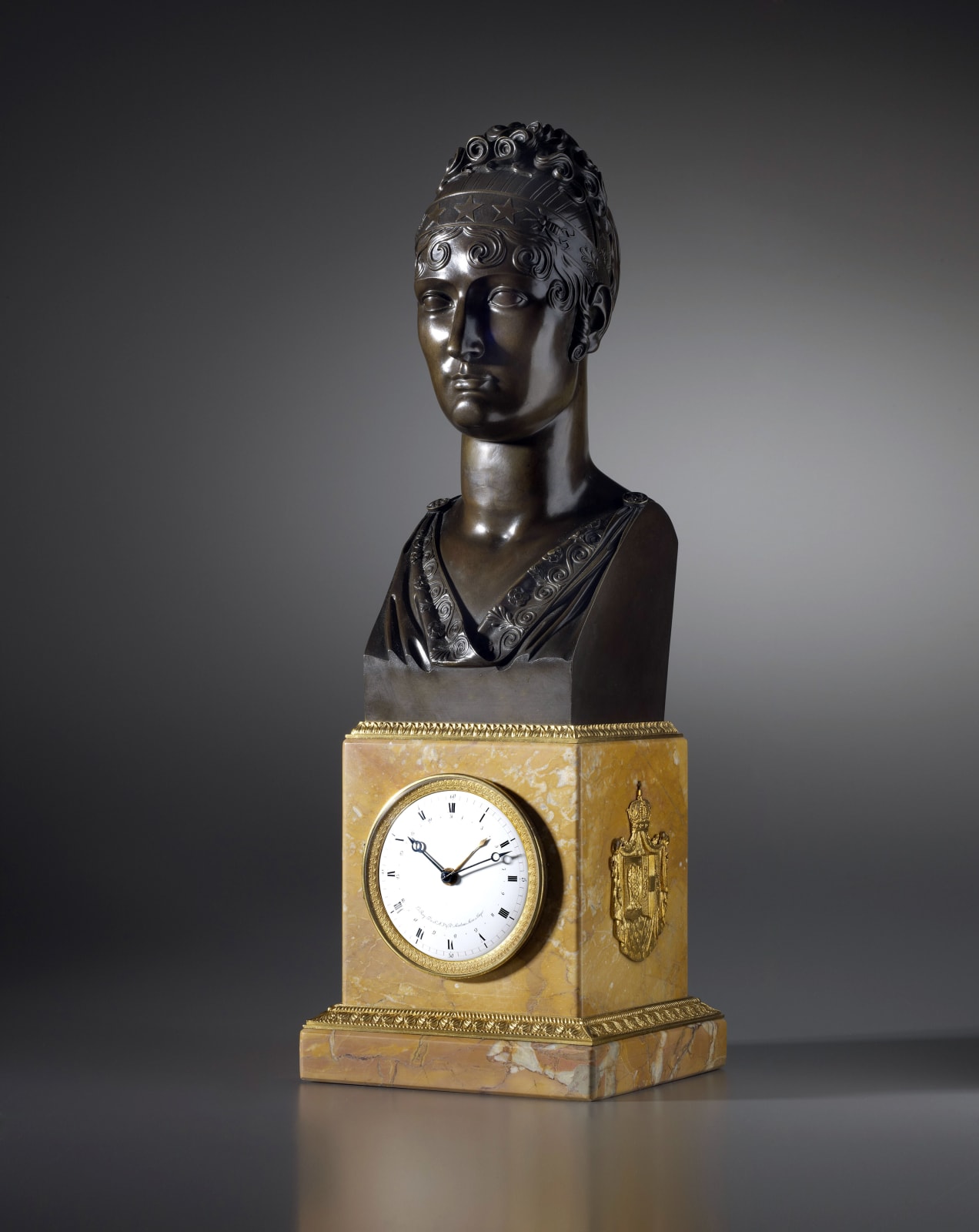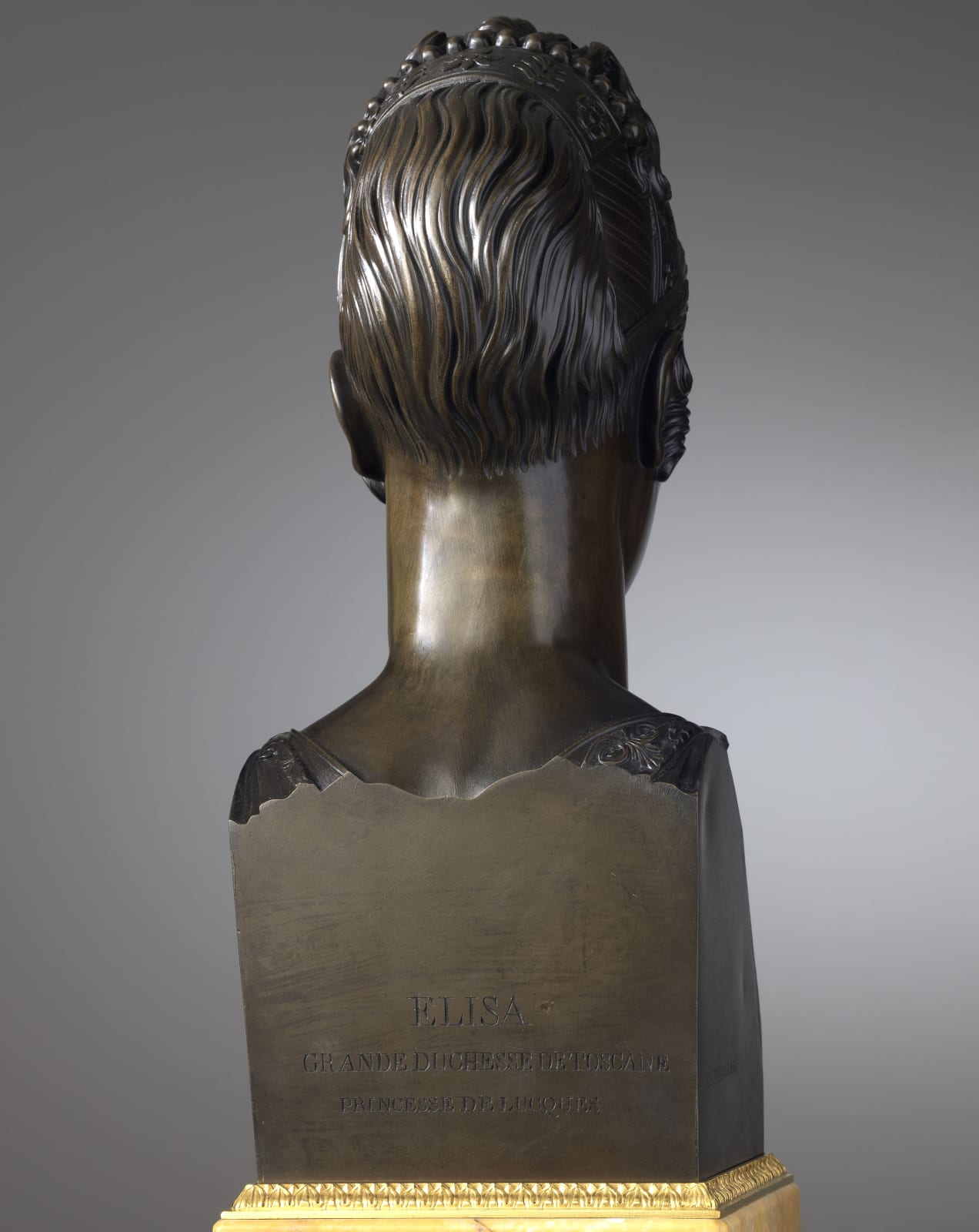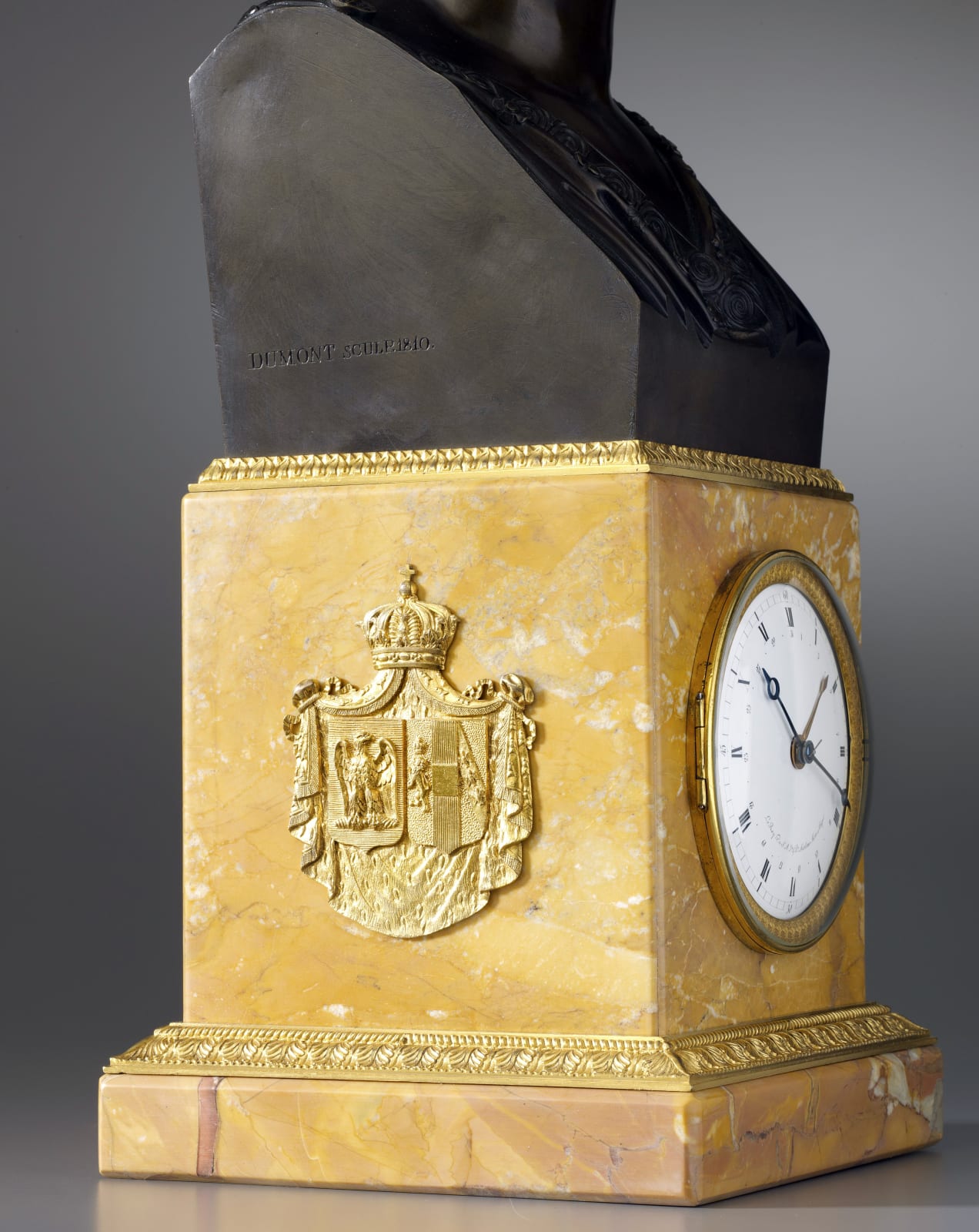Basile-Charles Le Roy
Further images
Provenance
Most probably given by Napoleon's sister Princesse Elisa Baciocchi, grande-duchesse of Tuscany to the Empress Marie-Louise on the occasion of her marriage to Emperor Napoleon in 1810.
Literature
Contents from Villa Demidoff, Pratolino, near Florence, sold by order of H.R.H. Prince Paul of Yugoslavia, Sotheby's London, sale catalogue, 21-24th April 1969, lot 226, illustrating a comparable clock. Pierre Kjellberg, "Encyclopédie de la Pendule Française du Moyen Age au XXe Siècle", 1997, p. 414, pl. C, illustrating a very similar clock with the same classical bust and Imperial mounts but differing dial, likewise by Basile-Charles Le Roy, which was given as a wedding gift by Elisa Grand Duchess of Tuscany to the Empress Marie-Louise when she married Emperor Napoleon in 1810.
A very important Empire gilt and brown patinated bronze and Sienna marble mantel clock with movement by the Imperial clockmaker Basile-Charles Le Roy and bronze bust by Jacques-Edmé Dumont, signed on the main dial Le Roy Horloger de S.A.I et R. Madame Mère de L'Empereur and also signed on the subsidiary dial beneath the bust Le Roy à Paris, further signed and dated on the side of the bronze DUMONT sculp. 1810 and inscribed with the name of the sitter on the reverse: Elisa Grande Duchesse de Toscane Princesse de Lucques, the circular white enamel dial set within a Sienna marble plinth with Roman numerals and an calendar ring indicating the 31 days of the month with a pair of blued steel Breguet style hands for the hours and minutes and brass gilt pointer for the calendar indications. Below the surmounting detachable bronze bust a subsidiary dial for adjusting the strike mechanism for night or day which also sets the calendar indications showing Arabic numerals 6/12/5 above for the day marked Midi and Roman Numerals below for the night marked VI/XII/V below marked Minuit with an outer ring marked 15/30/45/60, with a pair of Breguet style hands. The movement visible below the dial with twin barrels, silk thread suspension, anchor escapement and striking on a single bell.
The whole surmounted by a bronze bust of Princesse Elisa Baciocchi-Bonaparte, Grand Duchess of Tuscany and Princess of Lucca with her hair worn in ringlets and stars on her headdress and a V-neck shaped gown, her bust on a stiff-leaf cast border, upon a stepped rectangular Sienna marble plinth mounted either side with the gilt bronze Imperial crest of Napoleon Bonaparte Emperor of Austria
Paris, dated 1810
Height 59 cm.
Since this clock shares so many similarities with another clock (as illustrated in Kjellberg), it is asserted that the present clock was also given by Princesse Elisa Baciocchi, grande-duchesse of Tuscany to her sister-in-law the Empress Marie-Louise on the occasion of her marriage to Emperor Napoleon in 1810. Both portray Elisa Baciocchi and are signed by the sculptor Jacques-Edmé Dumont (1761-1844); both have movements by the royal clockmaker Basile-Charles Le Roy (1765-1839) and likewise each has a detachable head and is mounted at the sides of the plinth with Napoleon's Imperial crests.
There is an almost identical clock, likewise with a Sienna marble plinth but showing a lunar dial in the Mobilier National Français. A similar clock, likewise by Le Roy but with a differing classical bust and holes on the sides of the plinth (presumably to accommodate Imperials crests) was once in the Demidoff Collection and was later sold by this gallery. The latter was probably acquired from Basile-Charles Le Roy by his patron Jérôme Bonaparte, King of Westphalia (brother of Napoleon and Elisa), and thence to his daughter Mathilde Bonaparte, who married Anatole Demidoff 1st Prince di San Donato.
Such an illustrious provenance combined with the fact that the present bust portrays Napoleon's sister and that the makers of the movement and the case were both leader's in their respective field marks this clock of singular importance. The movement was made by the esteemed maker Basile (also known as Bazile)-Charles Le Roy who, born in Paris, was the son of the clockmaker Bazile Le Roy (1731-1804). Basile-Charles founded the House of Le Roy at 60 Galerie de Pierre, Palais-Royal shortly after 1785 when the duc d'Orléans (Philippe Egalité) opened up the Palais-Royal gardens to the public and the buildings to the trade. This enabled Le Roy and a number of other clockmakers to set up shop in the arcade galleries. During the Revolution he worked for the Republic signing his clocks 'Elyor'. Afterwards he moved his business to Galerie Montpensier, 13-15 Palais-Royal, where the concern was to remain for almost a hundred years. The following years saw his appointment as clockmaker to Emperor Napoleon and to the latter's mother Madame Mère, which he proudly announced on the present main dial.
In addition he was appointed clockmaker to Princess Pauline and Jérôme Bonaparte King of Westphalia and later in 1829 royal clockmaker to the ducs de Bourbon and de Chartres. His house exhibited clocks at the Paris Exposition l'an VI (1797/8) and again in 1819, 1823 and 1827. Basile-Charles Le Roy was highly innovative taking out a patent for one of his atmospheric clocks in 1823. In addition to this wonderful example, two other mantle clocks by him can be seen at the Ministère de la Guerre, Paris. When his son Charles-Louis (also known as Louis-Charles, 1794-1865/66) went into partnership with him in 1828 the business was renamed Le Roy et Fils. Charles-Louis proved equally successful in running the concern and in 1835 was appointed Horloger du Roi and Horloger du Ministère de la Marine.
The bust of the grande-duchesse was made by Jacques-Edmé Dumont (1761-1844), who came from a large dynasty of acclaimed sculptors. A pupil of Augustin Pajou, in 1788 Dumont won the coveted Prix de Rome and continued to live in Italy until 1793 when he returned to France in the hope of securing a commission from the National Convention. As no such order came Dumont began making his name for his for small statuettes, medallions and then later for large scale statues including one of Louis Henri Duc de Bourbon. He also produced a number of fine portrait sculptures including one of his mother (Musée du Louvre) and also one of Napoleon's second wife Marie-Louise. The present portrait bust is modelled on a marble by Lorenzo Bartolini (1777-1850), which itself was inspired by a marble by Joseph Chinard (1756-1813). Chinard's portrait, now in the Musée du Château de Fontainebleau, shows the Duchess wearing a squared Empire line dress with frills at the shoulders and a diadem in her braided hair, whereas Bartolini's version of circa 1810, (Musée du Château de Malmaison et Préau) portrayed her as here in a scooped V-line dress and hair in ringlets.
The sitter, Maria Anne, Elisa Bonaparte Baciocchi Levoy, best known as Elisa (1777-1820) was the younger sister of Napoleon and wife of Felix Baciocchi Levoy. Known for her beauty as well as her strong personality, she was the only one of the Emperor's sisters to hold real political power which she exerted in her role as Duchess of Lucca, Princess of Piombino and Grand Duchess of Tuscany by making many reforms to the existing religious, educational, medical, and charitable institutions as well as instigating a number of new art and architectural schemes. Her strong will and independence did not always accord with Napoleon and by the time of his second marriage in 1810 relations between the siblings was strained. Following his downfall and exile to Elba she was arrested but then released and allowed to stay at Trieste with the title Countess of Compignano and thereafter developed an interest in archaeology; it was probably during an excavation that she contracted a fatal disease. She died aged 43 and was buried in the San Petronio Basilica Bologna.
Elisa shared Napoleon's passion for the arts. In 1805 he awarded her the principalities of Piombino and Lucca and the following year added Massa and Carrara under her charge. Since Carrara was the main supplier of the finest white marble to Europe and Elisa was keen to combine financial and artistic interests, she established an Académie des Beaux-Arts there to host the greatest sculptors and thus make Carrara an exporter of marble statues, which had a greater value than the unfinished marble blocks. She also recommended that Napoleon should send one of his favourite sculptors, Lorenzo Bartolini to direct the school at Carrara. In addition to Elisa herself, Bartolini executed a nude statue of her daughter Napoléone Elisa with her dog (Cleveland Museum of Art) and a monument to the Grand Duchess herself of which the plaster model is housed at the Accademia, Florence.





